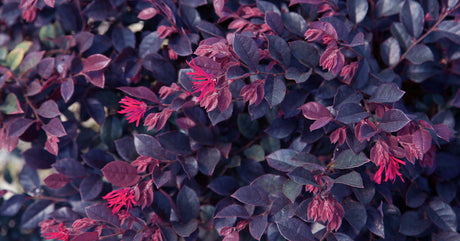

Planting and Care Tips for Loropetalums
|
|
Time to read 3 min
|
|
Time to read 3 min
Loropetalums, often known as the Chinese fringe flower, is a gorgeous evergreen shrub that brings a distinctive charm to any garden or landscape. Loropetalum is a group of evergreen shrubs originating from Asia. It belongs to the witch hazel family and is known for its vibrant leaves and unique flowers. The leaves come in shades from deep purple to green, often glossy, and the flowers that bloom in spring are small yet vibrant with shades of pink, red, or white.
There are various Loropetalum varieties, each with its unique features. Popular options include 'Ruby' with deep burgundy leaves, Purple Diamond with pink flowers, and Emerald Snow with white blooms. Whether you prefer a compact shrub or a larger specimen, there's a Loropetalum variety to meet your gardening needs.
Loropetalum provides several gardening advantages. It is a low-maintenance plant, requiring minimal pruning, and is generally resistant to pests and diseases. Loropetalum is also drought-tolerant once established, making it an excellent choice for water-wise gardens. This versatile shrub can be grown as a hedge, a specimen plant, or even in containers, offering endless design possibilities for your garden.
Loropetalum thrives in full sun to partial shade, so pick a location that receives at least 6 hours of direct sunlight daily. The soil should be well-drained, as Loropetalum prefers moist but not soggy conditions. Most loropetalums thrive in USDA Zones
Prepare the soil by loosening it with a garden fork or tiller and remove any competing weeds or grass. Incorporate organic matter such as compost or peat moss to improve soil fertility and drainage.
When planting Loropetalum, dig a hole twice as wide and deep as the root ball. Place the plant in the hole, ensuring the top of the root ball is level with the ground. Backfill the hole with soil, gently firming it around the plant's base. Water thoroughly to settle the soil and remove any air pockets.
Proper watering is crucial for Loropetalum's growth. Water your plants deeply and regularly, especially during dry periods. A good guideline is to provide 1 inch of water per week through rainfall or supplemental irrigation. Avoid overwatering to prevent root rot.
Fertilize your Loropetalum with a balanced, slow-release fertilizer in early spring. Avoid high-nitrogen fertilizers, as they may promote excessive leaf growth at the expense of flower production. Following these guidelines, your Loropetalum will thrive and enrich your garden with stunning flowers and attractive foliage.
Here are some tips for maintaining a healthy Loropetalum:
When to prune Loropetalums?
Prune in early spring before new growth to encourage bushier and denser growth. Remove dead, damaged, crossing, or overcrowded branches to promote better airflow and prevent diseases.
Winter Care for Loropetalums
Although Loropetalum is generally hardy, some protection during harsh winters is beneficial. Apply a thick layer of mulch around the base to insulate the roots and prevent frost damage. Covering the plant with burlap or a frost blanket in colder regions can help it survive freezing temperatures.
Pest and Disease Prevention for Loropetalums
Regularly inspect for pests like aphids, spider mites, and scale insects, and treat promptly with insecticidal soap or horticultural oil. Ensure good air circulation and avoid overwatering to prevent fungal diseases.
Container gardening is a fantastic way to enjoy Loropetalum in small spaces, patios, or balconies. Choose a pot at least 2-3 times the size of the plant's root ball, with drainage holes to prevent waterlogging. Use a well-draining potting mix and place your container in a location that receives partial to full sun. Water regularly, allowing the top inch of soil to dry out between waterings. Fertilize during the growing season with a balanced, slow-release fertilizer. When repotting, select a slightly larger pot and follow the same guidelines for potting soil and drainage.
